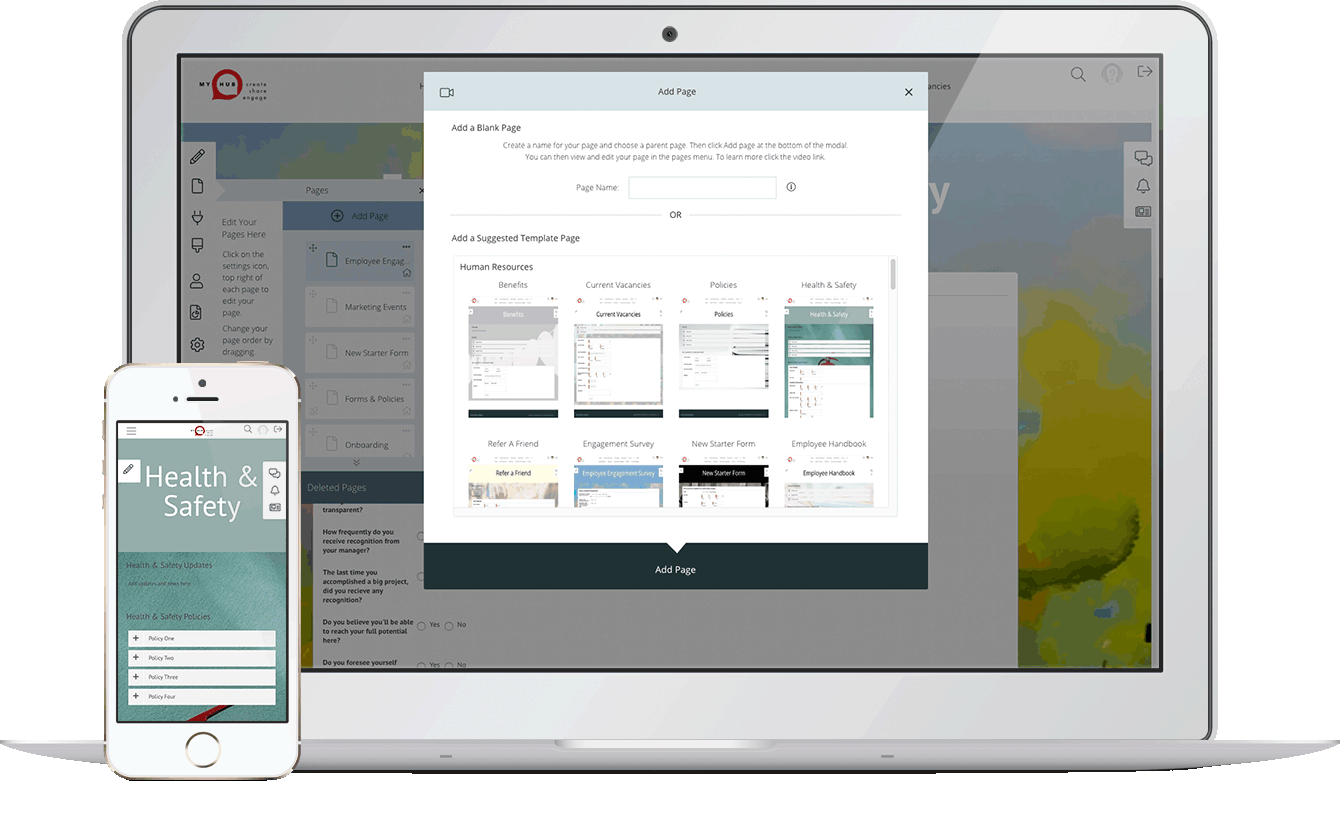Knowledge Management
Leverage the collective wisdom of your staff with a knowledge management hub
Search. Share. Grow

Most managers embarking on knowledge management initiatives are looking to create a knowledge-rich environment where the best minds of the business share their wisdom; where critical business intelligence no longer hides in the dark; and brilliant work is never lost on a local drive.
Here we explore the benefits and importance of knolwede management, and how you can build a knowledge-sharing culture where information flows freely throughout your organization.
What Is Knowledge Management?

Gartner Group’s definition of knowledge management is:
“Knowledge management is a discipline that promotes an integrated approach to identifying, capturing, evaluating, retrieving, and sharing all of an enterprise’s information assets. These assets may include databases, documents, policies, procedures, and previously un-captured expertise and experience in individual workers.”
The three main areas of knowledge management consist of:
1) accumulating knowledge
2) storing knowledge
3) sharing knowledge
Organizations with effective knowledge management in place are typically better at making good decisions; achieving business goals; onboarding staff quicker; and innovating.
What Are The Main Benefits Of A Knowledge Management System?

Successful knowledge management can improve your organization in many ways.
- It ensures specialized knowledge held by employees does not walk out the door if they leave.
- It ensures learning, idea-sharing, and collaboration amongst staff occur habitually.
- It ensures internal efficiencies and business outcomes are maximized thanks to staff know-how.
As for the bottom-line, any business focused on improving the management of knowledge can expect better product adoption, lower customer churn rates, and improved loyalty from both customers and staff.
Why Is Knowledge Management Important?
The average large US business loses $47 million in productivity each year as a direct result of inefficient knowledge management.
According to the Panopto Workplace Knowledge and Productivity Report, U.S. knowledge workers waste nearly six hours each week either waiting for vital information from their co-workers, or recreating existing institutional knowledge. That wasted time translates into delayed projects, missed opportunities, frustration among employees, and a significant impact on the bottom line.
In this unprecedented study of more than 1,000 U.S. workers, the Workplace Knowledge and Productivity Report revealed that 42 percent of institutional knowledge is unique to the individual. If that individual leaves or becomes unavailable, that’s 42 percent of that job unable to be fulfilled by others.
Therefore the main goal of knowledge management is to improve an organization’s efficiency and save knowledge within the company. It’s made up of a cycle of creating, sharing, structuring and auditing knowledge, in order to maximize the effectiveness of an organization’s collective knowledge.
Today, many businesses complain their staff lose valuable time due to poor information management. Trying to locate the right version of a document; wading through poorly-named files and folders; and lost expertise are just some of the recurring challenges, exacerbated as the digital revolution accelerates and the volume of information presented is non-stop.
The goal is to enable organizational learning and create a learning culture, where the sharing of knowledge is encouraged and those who seek to learn to better themselves find it easy to do so.
Knowledge Types
Generally speaking, there are two types of knowledge: explicit knowledge and tacit knowledge. What does this mean in a business sense?
Explicit Knowledge
Explicit knowledge is tangible. It can be captured and written down. Think of internal processes, customer insights, instruction manuals, training documents, best practice procedures, and research findings – these are all examples of explicit knowledge that is valuable intellectual property within an organization.
Tacit Knowledge
Tacit knowledge is much harder to capture as it typically comes from personal experience. Therefore it can be difficult to transfer from one person to another – for example, leadership skills or how to innovate. But tacit knowledge offers a competitive advantage because it’s almost impossible for a competitor to mimic.
Most organizations today recognize both knowledge types are essential to hold on to, and that a knowledge management strategy – supported with the right technology – is needed to maintain core capabilities over time.
In other words, effective content management that can facilitate collaboration, uncover innovations, and present content to employees – or third parties – when they need it most provides a competitive edge.
Knowledge Management – Risks And Benefits
What’s At Stake?
A lack of knowledge management processes can create a chaotic working environment. The risks include:
- Valuable expertise and know-how is lost when a good employee leaves
- Correct and current processes are difficult to pinpoint, potentially compromising an organization
- Ideas may not get captured or actioned, especially from those who are less likely to speak up
- Timely information retrieval is a challenge; staff either give up or recreate their own
- Sensitive or confidential information falls into the wrong hands, putting the organization at risk
- Knowledge is trapped within siloes, reducing efficiency
- Knowledge transfer to outsourced parties is impeded
- Organizational learning is limited, restricting employees’ personal development
What’s To Gain?
Strategic-thinking, open-minded organizations that have embraced a better way to manage knowledge benefit from:
- Efficient decision-making across all teams and all levels, with successful outcomes
- Idea-sharing and collaboration amongst staff occurs habitually
- Improved organizational agility; knowing when to pivot or preserve
- Generous sharing of specialist expertise takes place across all functions
- Greater understanding – and therefore adoption – amongst staff of business processes
- Innovation and ideation encouraged across the entire business
- Communities of practice and experimenting fuel growth
- Prevalence for professional development and staff mentoring, as knowledge cascades throughout the company
❝
More than a third of an employee’s day is spent looking for information
Source: www.adenin.com
What Is A Knowledge Management System?
For Employees
Knowledge management systems feature within departments, project teams, and companies. The most common tool for managing knowledge is the modern-day intranet. These days, they are part portal, part communications app, part collaboration tool, and part file-storage. This tool has come a long way since first introduced, with features such as forums, project management workflows, wikis, blogs, newsfeed and more.
For Customers
A knowledge management system is also now being used externally as a knowledge base for customers. Critical components include FAQ sections, How-to articles, tutorials, and community forums. Increasingly, big data in the form of customer behavior and analytics is also residing in KM systems.

Which Knowledge Management Tools and Features Are Important?
There are now multiple information systems and tools designed for knowledge sharing.
At a basic level, document management software such as Google Drive or Box can suffice. These cloud-based tools allow for tagging files and adding metadata that make information easier to find.
But these days, most organizations prefer tools that perform a range of tasks and can manage diverse content, including rich media, social and web content.
These tools must perform the following:
Search
An essential function that speeds up the time it takes to locate information
Knowledge Visualization
Graphics, illustrations, powerpoint slides, web pages support learning and knowledge flow
Collaboration
Instant messaging, automated emails, and unified communications
Decision Support
Analytics and reporting software that empowers staff to identify trends and patterns
Socialization
Tools for easy sharing, with the ability to add comments and likes (such as forums, blogs and # chat channels)
Targeting And Relevancy
Reduce (not increase) information overload, email burden and white noise
How To Build A Knowledge Management System
Once you have selected your information technology system to support your KM strategy, the main steps in developing a knowledge management system comprise the following:
1. Source The Information And Data
What are the common questions staff have; what processes must they know; what are the repetitive tasks; what intellectual capital resides in silos.
4. Measure Engagement
Track metrics to ascertain which content is the most popular; identify the gaps; and ask staff for feedback.
2. Compile The Information In An Organized Way
Bundle content into agreed topic categories; prioritize sought-after knowledge in your navigation; include links to other related content; present content in multi-formats (video tutorials, FAQs, forums).
5. Keep Content Fresh
Use forums and feedback forms to uncover gaps and missing knowledge assets. Encourage staff to add self-serving content so the responsibility of updating intellectual property is shared.
3. Promote Adoption
Encouraging staff to use a knowledge management system can be the hardest part. If you’re the chief knowledge officer, solicit senior stakeholder buy-in, and identify knowledge champions to promote sharing practices.
6. Check Permission Controls
Consider which of your content may need restricted access, and whether employee-facing information can be re-purposed for customer-facing use.
Knowledge Management – Next Steps
A Knowledge Management System should form an essential part of your human resource strategy to drive business growth. Partnering with the right IT solution pay dividends in the future, since your team will collaborate more effectively and customers will be more loyal.
Scalability, simplicity and affordability are important considerations: your KMS will become a living system with a long shelf-life. Done right, it can help you to create, share, and manage knowledge that leads to competitive business edge.
MyHub’s intranet software is designed to help businesses of all shapes and sizes to communicate better, and scale knowledge management practices. Discover MyHub’s Knowledge Management Solution.
MyHub Knowledge Management Case Studies
Sharing Knowledge Customer-Wide
Discover how professional services provider Sass introduced an extranet knowledge base that created value for clients, saved the team from repetitive tasks, and gave Sass a competitive advantage.
Legal Firm's Quick-Find Knowledge Hub
Read a case study on how Turnbull Hill Lawyers use their central knowledge management portal for everything from policies and procedures, to training and onboarding.
Useful Knowledge Management Resources
No Results Found
The page you requested could not be found. Try refining your search, or use the navigation above to locate the post.

